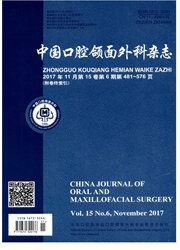

 中文摘要:
中文摘要:
目的:以传统咬合板为参照,评价3D咬合板的临床可靠性;通过手术前、后三维头影测量,评价3D咬合板的精确性。方法:选择颅颌面畸形患者15例,术前制作传统咬合板,使用Mimics 10.01软件在锥形束CT(CBCT)重建三维模型上进行虚拟手术及3D咬合板设计,并由Objet Eden260VTM 3D Printer打印3D咬合板。术中先后使用3D咬合板和传统咬合板,统计3D咬合板的成功率。术后1周复查CBCT,进行三维头影测量。手术前、后分别进行3次重复定点测量,使用SPSS13.0软件包和MedCalc13.1.2软件对数据进行统计学分析。结果:15例3D咬合板的成功率为100%,三维头影测量的24个线距测量值和24个面角测量值在虚拟手术与实际手术间无显著差异(P〉0.05)。线距测量值具有良好的一致性,角度测量值一致性欠佳。结论:3D咬合板具有一定的临床适用性,但其精确性有待提高。
 英文摘要:
英文摘要:
PURPOSE: To estimate the reliability of 3D occlusal splints compared with traditional occlusal splints, and to evaluate the accuracy of 3D occlusal splints through 3D cephalometry. METHODS: Fifteen patients with maxillofacial deformity were involved in this experiment. Traditional occlusal splints were made pre-operatively, and virtual surgery was performed on 3D maxillofacial model. Then 3D occlusal splints were printed by Objet Eden260VTM3 D Printer. During the actual surgery, both splints were used to check the fitness of 3D occlusal splints. Cone-beam CT was taken 1 week after surgery. 3D cephalometry was repeated 3 times for both virtual and actual surgery. SPSS13.0 software package and MedCalc13.1.2 software were used for statistical analysis. RESULTS: All the 3D occlusal splints were successfully used in the surgery, and no significant difference was found between virtual surgery and actual surgery(P 〉0.05). Good consistency was obtained in distances rather than in angles. CONCLUSIONS: Three-dimensional occlusal splints were qualified clinically with the accuracy to be improved in future.
 关于曾融生:
关于曾融生:
 同期刊论文项目
同期刊论文项目
 同项目期刊论文
同项目期刊论文
 期刊信息
期刊信息
